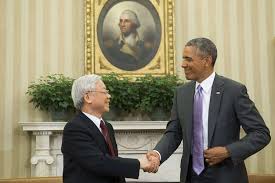After a long four-decade war, the United States completely lifted its arms ban on Vietnam. The historic move happened amid the rising tension in China, but Pres. Barack Obama pointed out that the decision was not because of China or even other matters.
The announcement came during Obama’s first visit to Hanoi. He is the third American president to visit Vietnam after diplomatic relations were reinstated in 1995. His foreign policy priority is the “strategic re-balance toward Asia.” Vietnam is an important factor in that strategy since it borders China and Beijing has been forcefully asserting its sovereignty to 80% of the South China Sea.
In a joint news conference with Vietnamese President Tran Dai Quang, Pres. Obama stated that the dispute in the South China Sea should be settled diplomatically and not by any country imposing its authority, especially on less powerful nations, in order to get what it wants. He further stressed that the lift on ban was not because of the issue with China, or with any other considerations for that matter, but “based on our desire to complete what has been a lengthy process of moving towards normalization with Vietnam…hearts can change and peace is possible.”
The decision was also made despite concern that Vietnam had not addressed its human rights issue. But as early as two years ago in 2014, Obama’s administration has already slowly eased the tension with its long-time enemy by allowing Vietnam to purchase maritime surveillance and “security-related” systems in order to empower the country especially against China.
The complete ban or arms embargo now entitles Hanoi to buy a full range of U.S. weapons and military equipment such as drones, radar, coastal patrol boats and possible P-3 Orion surveillance aircraft. Vietnam cannot make instant major purchases at the moment because it still has to resolve its human rights commitments. Until then, the sale of weapons will be made on a case-to-case basis.
